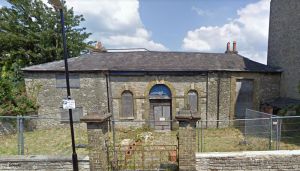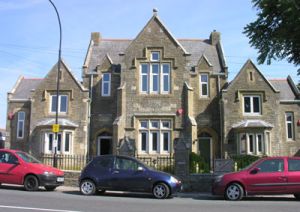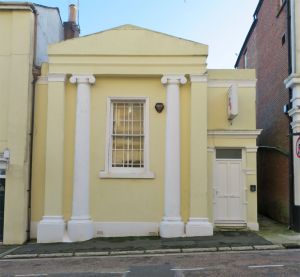Ryde, National Schools
There were three National Schools at Ryde in the mid 19th century; one established in 1812 in Melville Street for the children of St. Thomas's church, one in St. James's Street for the children of St James's Church, and another one in Player Street for the children of Holy Trinity church.
By 1911 the schools came under the Ryde Education Committee; 1921 saw the County Education Committee taking over the responsibilities for the Ryde Education Committee.
St Thomas's National Schools
The original St Thomas's National Schools established in Melville Street in 1812. A new building was constructed in Green Street, Ryde, Isle of Wight in 1856 and the Schools moved there - the original Melville Street building was sold and was rented, from the new owners, to the Isle of Wight Philosophical and Scientific Society as a museum[1].
The Green Street National Schools building was designed by Mr. Thomas Dashwood of Ryde, and built by Messrs. Dashwood. The new building cost £2000 which was funded by £450 from the sale of the Melville Street property, £850 subscribed by the 'local nobility, gentry, and others', and the remaining £700 guaranteed by a grant from the Council of Education. The inscription on the building in Green Street reads 'RYDE NATIONAL SCHOOLS ESTABLISHED 1812'. The school had space for 600 children and had residences attached for the master and mistress[2].
By 1911 the school came under the Ryde Education Committee and was known as Green street Elementary School; and the average attendance was 120 boys, 100 girls, 90 infants[3].
At different times, the building was used as the Lower School for Bishop Lovett Secondary School (originally Ryde Church of England Secondary School), and later by Greenmount School.
Following the removal of Greenmount School to their new site in 2011, the building was converted to a number of residential units.
St James's National Schools
The 1856 OS map of Ryde, and White's 1859 directory, shows a National School for Boys and Girls in St. James Street; today (2023) the British Legion Club.
A report in 1872 records that the St James's National Schools had undergone some alterations and that management of the schools had passed to Mrs. Thomas Dashwood[4].
Holy Trinity National Schools
A new building, costing £200, was erected in 1857 in Player Street to house 200 boys and girls together with a cottage for the master and mistress. The school was to the design of Mr. Newman and built by Mr. Denham, jun.[5]
In 1911 the Player street Elementary School could accommodate for 280 children and with average attendance was 84 boys, 78 girls, and 67 infants.
As part of the County's reorganisation of island education in 1970, the school, then known as Ryde CE Junior School, closed and the buildings used for other purposes before being demolished and the site re-developed.


